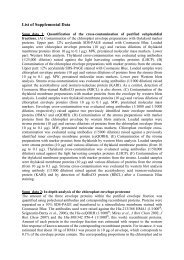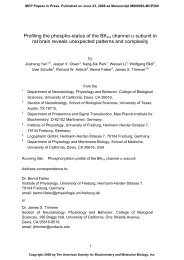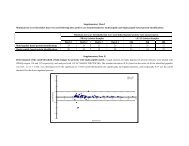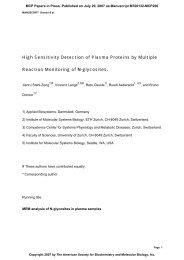Super-SILAC allows Classification of Diffuse Large B-cell ...
Super-SILAC allows Classification of Diffuse Large B-cell ...
Super-SILAC allows Classification of Diffuse Large B-cell ...
Create successful ePaper yourself
Turn your PDF publications into a flip-book with our unique Google optimized e-Paper software.
germinal center including diffuse large B <strong>cell</strong> lymphomas (36). This finding supports the potential use <strong>of</strong><br />
SLIP-GC as a potential marker that can be used to differentiate the two subtypes from each other.<br />
Another member <strong>of</strong> the signature set is the surface marker CD81, which has also very recently been<br />
reported to be highly expressed in normal germinal B <strong>cell</strong>s. Further assessment <strong>of</strong> the role <strong>of</strong> this <strong>cell</strong><br />
surface marker in the risk stratification <strong>of</strong> patients with DLBCL has already been recommended (37). A<br />
further novel protein that has a higher expression level in our GCB-DLBCL signature is the signaling<br />
adaptor Cbp/PAG. In B-<strong>cell</strong> non-Hodgkin lymphomas, PAG and Lyn kinase constitute the core <strong>of</strong> an<br />
oncogenic signalosome that results in proliferative and pro-survival signals. The Lyn and PAG<br />
signalosome can interact with downstream kinases to mediate these signals in different lymphoma <strong>cell</strong><br />
lines (38). Our finding that PAG is upregulated in GCB suggests investigating the modality associated<br />
with PAG in this subtype in particular. Ymer, a protein that we previously identified as an effector <strong>of</strong> EGF<br />
signaling (10, 39), is relatively upregulated in the ABC subtype. Ymer is also known as CCDC50 and,<br />
although not studied in the context <strong>of</strong> DLBCL, this protein has been shown to be required for the survival<br />
in chronic lymphocytic leukemia (CLL) and mantle <strong>cell</strong> lymphoma (MCL) <strong>cell</strong>s (40). It is involved in the<br />
control NF-κB signaling which is a characteristic <strong>of</strong> the ABC subtype where it is upregulated (41).<br />
Therefore, in addition to validating differentiators known from gene expression pr<strong>of</strong>iling, our proteomic<br />
signature reveals a novel set <strong>of</strong> proteins some <strong>of</strong> which have been shown to be involved in<br />
lymphomagenesis and might be <strong>of</strong> clinical relevance.<br />
In an attempt to identify annotated protein categories that are significantly and exclusively upregulated<br />
in one lymphoma subtype relative to the other, we plotted the difference <strong>of</strong> mean ratios versus the<br />
statistical significance <strong>of</strong> our signature proteins. This revealed that all NF-κB regulated proteins are<br />
significantly upregulated in ABC relative to GCB subtype (Figure 6B). They included IRF4, CD44, Ymer,<br />
PTP1B, ICAM and HLA-C. Thus, our proteomic findings – similar to previous results <strong>of</strong> gene expression<br />
[16]








